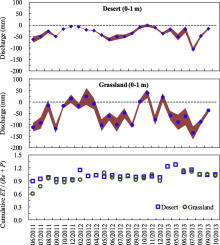当前位置:
X-MOL 学术
›
Ecol. Eng.
›
论文详情
Our official English website, www.x-mol.net, welcomes your feedback! (Note: you will need to create a separate account there.)
The dynamics of soil moisture balance components and their relations with the productivity of natural vegetation in an arid region of northwestern China
Ecological Engineering ( IF 3.8 ) Pub Date : 2020-01-01 , DOI: 10.1016/j.ecoleng.2019.105672 Danfeng Li , Mingan Shao , Shuaipu Zhang , Kun Zhang
Ecological Engineering ( IF 3.8 ) Pub Date : 2020-01-01 , DOI: 10.1016/j.ecoleng.2019.105672 Danfeng Li , Mingan Shao , Shuaipu Zhang , Kun Zhang

|
Abstract Precipitation and groundwater are important water source in soil and are vital for the survival and growth of natural vegetation in arid regions. Analyses on the dynamics of soil water balance components and their relations with plant growth are usually restricted by the lack of continuous measurement of deep soil moisture at a local or regional scale. By monitoring monthly soil water contents in the 0–3 m soil profiles, we analyzed the contributions of precipitation and groundwater to the growth of natural vegetation in an arid region of northwestern China from 2011 to 2013. The results showed that the 0–3 m desert soil and the 0–1.8 m grassland soil exhibited moderate spatial variability in the soil water contents (θ). Temporal variability of spatial mean θ decreased with depth in the soils of the desert and grassland. The profile-average of spatial mean θ maintained 0.11 cm3 cm−3 in the desert and varied from 0.37 to 0.44 cm3 cm−3 in the grassland over time. The evapotranspiration after calibration gave accurate estimation of water available for plants (402.0 and 532.4 mm year−1 in the desert and grassland, respectively). Annual mean net primary productivity of the grassland (233.4 g C m−2) was 3.8 times that of the desert. Water exchange in the desert soils was dominated by recharge into the 0–1 m soil from layers deeper than 3 m, with annual mean value of 303.4 mm. Recharge alternated with discharge events in grassland soils. Annual mean recharge and discharge amounts were 494.2 and 50.1 mm for the 0–1 m layer and 641.1 and 228.9 mm for the 0–3 m soil profile, respectively. Water supply into soil was totally consumed by evapotranspiration. Precipitation use efficiency increased when groundwater level became shallow (0.04 and 0.11 g C m−2 mm−1 in the desert and grassland, respectively). Groundwater supplied about 75% of water requirement for natural vegetation, and its use efficiencies were 0.12 and 0.33 g C m−2 mm−1 in the desert and grassland, respectively. Seedling of herbaceous species with trichomes at the interspace and under the canopy of shrubs can guarantee great utilization of precipitation in the desert. Transplanting of shrubs with large amounts of shallow lateral roots and shrubs with deep rooting systems can effectively utilize the shallow and deep soil water or groundwater. Reducing the irrigation consumption of groundwater and controlling the expansion of oasis cropland are foremost to guarantee the ecological water requirement and maintain the sustainability of natural ecosystems. Keep or increase current area and layout of the grassland may benefit the water cycle and carbon sequestration in the arid regions.
更新日期:2020-01-01



























 京公网安备 11010802027423号
京公网安备 11010802027423号